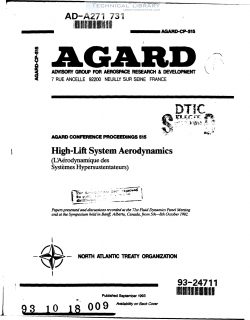AGARD-CP-515
- Version
- 490 Downloads
- 30.81 MB File Size
- 1 File Count
- May 10, 2017 Create Date
- May 10, 2017 Last Updated
Advisory Group for Aerospace Research & Development - High-Lift System Aerodynamics

The AGARD Fluid Dynamics Panel organized a symposium
on “High-Lift System Aerodynamics" which was held in
Banff. Alberta. Canada. from 5 October through 8 October.
[992. This meeting represented a natural successor to a pre-
vious FDP symposium held in Brussels, Belgium in l984.
which was entitled “Improvements of Aerodynamic
Performance through Boundary Layer Control and High-Lift
Systems“. Considerable progress has been made in the area
of high-lift systems since the Brussels conference, especially
in the areas of experimental testing and theoretical predic-
tion (otherwise referred to as computational fluid dynamics
or CFD).
in view of the current aerospace climate and corresponding
industrial interest. for the Banfi' symposium. it was decided
to focus attention on aerodynamic research and technology
applicable to advanced (passive) high~lift systems for sub-
sonic transport application. Notwithstanding this emphasis.
three papers were presented dealing with experimental test—
ing of low aspect ratio wing planftmns. suitable for combat
type aircraft and one dealing with powered—lift for transport
application.
The first paper contained a review of some past research
programmes in the United Kingdom and was presented by
Dr D.S. Woodward. co—chairman of the programme commit—
tee. Paper 3 was withdrawn so that. of the 13 papers which
followed. 1 l dealt with CFD 2D methods as applied to high-
lift airfoil configurations such as single or double—slotted
flap with some form of leading edge device. The next seven
papers concerned experimental testing of high—lift configura-
tions in 3D. The following session of four papers was devot-
ed to CFD methods as applied to 3D highdift wings and.
finally. seven papers were presented in which industrial rep—
resentatives described design and development of high-lift
systems for complete aircraft.
Typically. the aerodynamic high—lift design process in indus-
try involves the use of an empirical data base. theoretical
prediction methods, wind tunnel testing and flight develop-
ment.
The very beginning of high-lift can be traced back to the
years l9l7-l920 (I). but even after 30 years. mst of the
design data were compiled in just four publications (27). but
there was little understanding of the underlying aerodynamic
principles at work. It was not until 1972 that the theoretical
treatise of A.M.O. Smith provided a clear and comprehen-
sive insight into the fundamentals of a mum—element foil
(34). He showed that it was by splitting the pressure rise
over several elements that the tendency for flow separation
could be suppressed and. thereby. lift potential could be
increased.
| File | Action |
|---|---|
| AGARD-CP-515 High-Lift System Aerodynamics.pdf | Download |
Comment On This Post